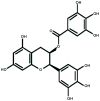Epigallocatechin-3-gallate attenuates neointimal hyperplasia in a rat model of carotid artery injury by inhibition of high mobility group box 1 expression
- PMID: 28962112
- PMCID: PMC5609174
- DOI: 10.3892/etm.2017.4774
Epigallocatechin-3-gallate attenuates neointimal hyperplasia in a rat model of carotid artery injury by inhibition of high mobility group box 1 expression
Abstract
Epigallocatechin-3-gallate (EGCG) is a kind of polyphenol compound, called catechin, and is extracted from green tea. EGCG has a wide range of biological activities. The present study aimed to evaluate the effect of EGCG on neointimal hyperplasia in a rat model of carotid artery balloon injury and to explore the molecular mechanisms involved. Various experiments were performed to assess the effects of EGCG on thickening of neointima, expression levels of high mobility group box 1 protein (HMGB1) and receptor of advanced glycation end products (RAGE), the inflammatory response, oxidative stress and activation of nuclear factor (NF)-κB. Results demonstrated that EGCG decreased the intimal area and the ratio of intimal area/medial area compared with the balloon injury group. The expression levels of HMGB1 and RAGE induced by balloon injury were markedly inhibited by EGCG treatment. Furthermore, the inflammatory response and oxidative stress damage, which have close correlations with HMGB1, were restrained by EGCG. Finally, EGCG treatment markedly inhibited NF-κB activation. The present data provided evidence that EGCG attenuates neointimal hyperplasia in a model of carotid artery balloon injury, which indicated that EGCG may serve as a potential drug for restenosis in clinics.
Keywords: epigallocatechin-3-gallate; high mobility group box 1; inflammation; neointimal hyperplasia; oxidative stress.
Figures






References
LinkOut - more resources
Full Text Sources
Other Literature Sources
